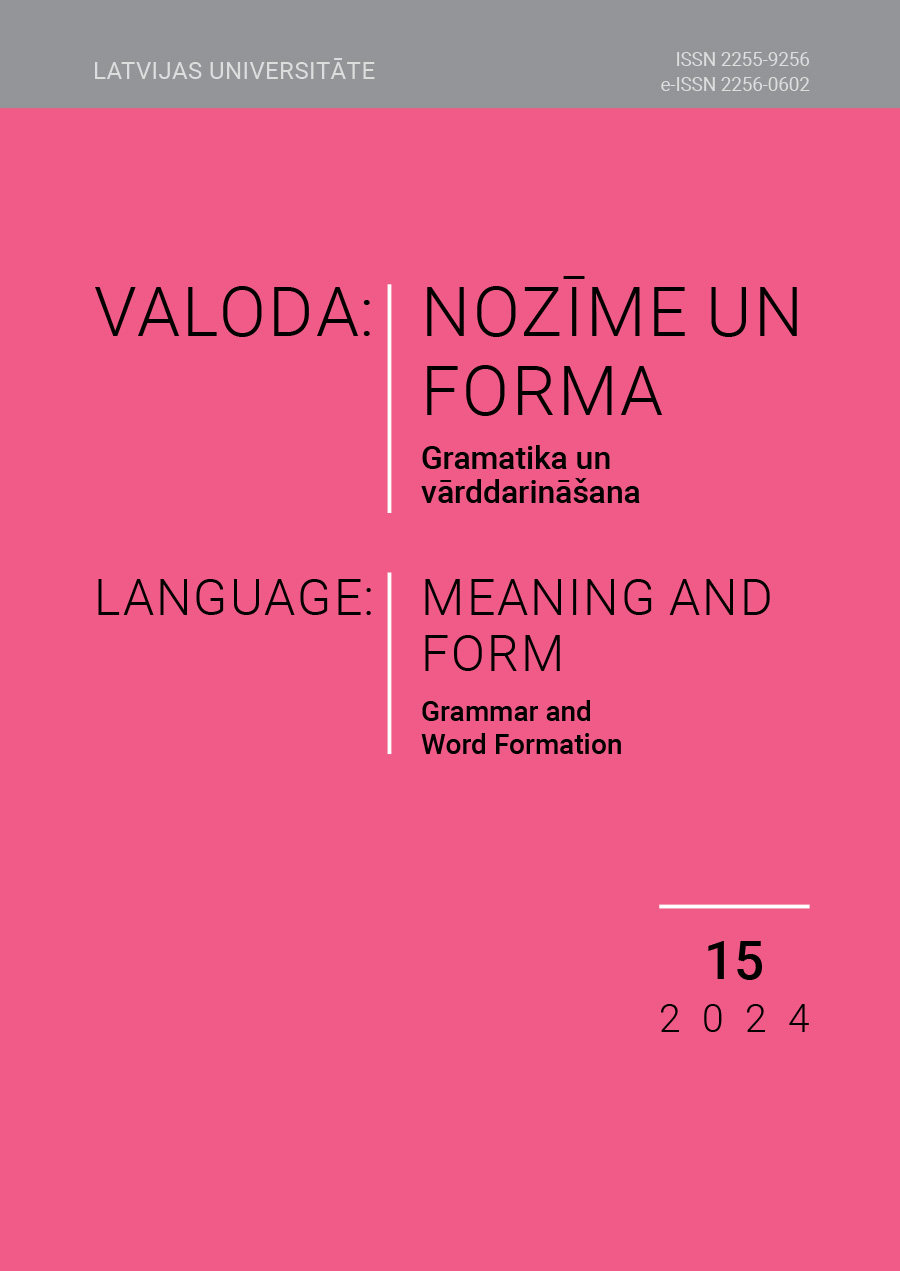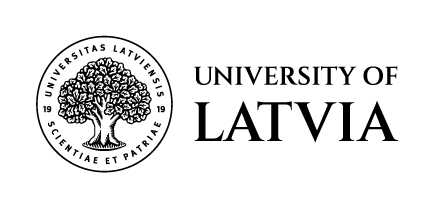Ethnolinguistic and sociolinguistic aspects of the gender category in Spanish
DOI:
https://doi.org/10.22364/vnf.15.10Keywords:
gender, sex, meaning, form, discrimination, inclusive languageAbstract
The study examines the creation and development of the grammatical category of gender in the Spanish language, its definition and application, as well as cultural and historical circumstances that have influenced these processes. The particular interest in the gender category is due to the sociolinguistic polemics among the modern Spanish society, mass media and linguists about the recommendations for inclusivity in using the language. The recommendations have been recently elaborated by linguists, as well as public and political institutions. In Spanish, there are two genders, feminine and masculine. There is no neuter, however, there are some common gender nouns. The representatives of feminism insist language is discriminatory towards women because the male gender forms denote both male and biologically unmarked nouns used to denote people collectively. The advocates of the inclusive language demand that the use of the unmarked gender be abandoned, replacing it with other forms. One of the most radical suggestions is to introduce the third gender. It is proposed to be made by adding the ending -e (-es in plural) and derived from the nouns already existing in the two gender forms, such as: maestro, maestra, maestre. At the terminology level, binom sexo/género (sex/gender in English) and the linguistic use of these terms raise interest. The results of the study lead to the conclusion that the language already is non-discriminatory and contains grammatical forms for describing gender neutrality. The claim that male dominance in society dictates their dominant role in language has not been substantiated by scientific evidence. Discrimination against women is a societal problem that has also found its reflection in language, mostly at the lexical level. The guidelines developed by several institutions for the implementation of inclusive language have not been supported by the Royal Academy of Spain and are described as efforts to create an artificial discourse.
References
Alarcos Llorach, Emilio. 1994. Gramática de la lengua española. Madrid: Espasa.
Anonīms autors. 1892. Gramática de la lengua vulgar de España. Viñaza, Conde de (red.). Zaragoza: La derecha. [Pirmizdevums – 1559.] Pieejams: https://www.rae.es/archivo-digital/gramatica-de-la-lengua-vulgar-de-espana#mode/2up
Correas, Gonzalo. 1984. Arte Kastellana. Taboada, Manuel Cid (ed.). Santiago de Compostela: Universidad de Santiago de Compostela. [Pirmizdevums – 1627.]
Jiménez Patón, Bartolomé. 2020. Instituciones de la Gramática española. Madrid: Fundación Ignacio Larramendi. [Pirmizdevums – 1614.] Pieejams: https://www.larramendi.es/es/consulta/registro.do?id=27926
Nebrija, Antonio de. 1492. Arte de la lengua castellana. Pieejams: https://bdh-rd.bne.es/viewer.vm?id=0000174208&page=1
Panizo Rodríguez, Juliana. 1992. La mujer en el refranero. Revista de Folklore. 144, 198–202. Pieejams: https://www.cervantesvirtual.com/obra-visor/la-mujer-en-el-refranero/html/
RAE. 1771. Gramática de la lengua castellana. Pieejams: https://www.rae.es/sites/default/files/Gramatica_RAE_1771_reducida.pdf
RAE. 2001. Diccionario de la lengua española. Pieejams: https://www.rae.es/drae2001/
RAE. 2009. Nueva gramática de la lengua española. Morfología y sintaxis I. Madrid: Espasa. Pieejams: https://www.rae.es/gram%C3%A1tica/
RAE. 2020. Informe de la Real Academia Española sobre el lenguaje inclusivo y cuestiones conexas. Pieejams: https://www.rae.es/sites/default/files/Informe_lenguaje_inclusivo.pdf
RAE. 2023a. Diccionario de la lengua española. Pieejams: https://dle.rae.es/contenido/actualizaci %C3 %B3n-2023
RAE. 2023b. Diccionario panhispánico de dudas. Pieejams: https://www.rae.es/dpd/espa %C3 %B1ol.
Sánchez Pérez, Aquilino et al. 1995. Gran diccionario de la lengua española. Madrid: Sociedad General Española de Libros.
Valdés, Juan de. 1982. Diálogo de la lengua. Barbolani, Cristina (ed.). Madrid: Cátedra. [Pirmizdevums – 1535.]
Villalón Cristóbal de. 2021. Gramática castellana. Mencé, Caster (ed.). [Pirmizdevums – 1557.] Pieejams: https://books.openedition.org/esb/2857
Álvarez de Miranda, Pedro. 2018. El género y la lengua. Madrid: Turner.
Ayala Castro, Marta Concepción, Guerrero Salazar, Susana. 2002. Manual de lenguaje administrativo no sexista. Málaga: Universidad de Málaga.
Bengoechea Bartolomé, Mercedes. 2017. Guía para la revisión del lenguaje desde la
perspectiva de género. Pieejams: https://www.euskadi.eus/contenidos/informacion/pol_clau_guias_publicaciones/es_def/adjuntos/Guia_lenguaje_perspectiva_genero.pdf
Bernárdez, Enrique. 2004. ¿Qué son las lenguas? Madrid: Alianza.
Bosque, Ignacio. 2012. Sexismo lingüístico y visibilidad de la mujer. Pieejams: https://www.rae.es/sites/default/files/Sexismo_linguistico_y_visibilidad_de_la_mujer_0.pdf
Calero Fernández, María Ángeles. 1999. Sexismo lingüístico. Madrid: Narcea.
Casado Velarde, Marnuel. 1991. Lenguaje y cultura. La etnolingüística. Madrid: Síntesis.
Corbett, Greville G. 2013. Number of genders. The World Atlas of Language Structures Online. Dryer, Matthew S., Haspelmath, Martin (eds.). Leipzig: Max Planck Institute for Evolutionary Anthropology. Pieejams: http://wals.info/chapter/30
Díaz Plaja, Guillermo. 1984. Ensayos sobre comunicación cultural. Madrid: Espasa-Calpe.
Duso, Antonella. 2017. Varro: De lingua latina. IX. Hildesheim: Georg Olms Verlag AG.
Escandell-Vidal, Victoria. 2018. Reflexiones sobre el género como categoría gramatical. Cambio ecológico y tipología lingüística. https://doi.org/10.13140/RG.2.2.27311.23205
García Meseguer, Álvaro. 1977. Lenguaje y discriminación sexual. Madrid: Edicusa.
García Meseguer, Álvaro, 2001. ¿Es sexista la lengua española? Panace@. 2, 20–34. Pieejams: https://www.tremedica.org/wp-content/uploads/n3_Panacea3_Marzo2001.pdf
González Calvo, José Manuel. 1979. El género, ¿una categoría morfológica? Anuario de estudios filológicos. 2, 51–53.
Grijelmo, Álex. 2019. Propuesta de acuerdo sobre el lenguaje inclusivo. Madrid: Taurus.
Guerrero Salazar, Susana. 2001. Medios de comunicación y estrategias lingüísticas no sexistas, Isla de Arriarán. Revista Cultural y Científica. 17, 405–417.
Gumperz, John Joseph, Hymes, Dell Hathaway. 1972. Directions in sociolinguistics. Communication. London: Basil Blackwell.
Hjelmslev, Louis. 1971. Prolegómenos a una teoría del lenguaje. Madrid: Gredos.
Humboldt, Wilhelm von. 1988. On language. The Diversity of Human Language-Structure and its Influence on the Mental Development of Making. Cambridge: Cambridge University Press.
Labov, William. 1974. Linguistic change as a form of communication. Human Communication: Theoretical Explorations. Silverstein, Michael (ed.). Hillsdal: Lawrence Erlbaum Associates.
Ledo-Lemos, Francisco José. 2003. Femininum Genus. Un estudio sobre los orígenes de género gramatical femenino en las lenguas indoeuropeas. Munich: Lincom-Europa.
Luque Nadal, Lucía. 2017. Aspectos fraseológicos y culturales de los co-compuestos o binomios léxicos. Language Design: Journal of Theoretical and Experimental Linguistics, (LD). 19, 149–204.
Martín Camacho, José Carlos. 2016. Hacia una caracterización de una disciplina lingüística casi olvidada: la etnolingüística. Estudios de lingüística. Universidad de Alicante. 30, 181–212. Pieejams: https://rua.ua.es/dspace/bitstream/10045/60774/3/ELUA_30_09.pdf
Martínez García, José Antonio. 1994. Propuesta de gramática funcional. Madrid: Istmo S.A.
Meillet, Antoine. 1926. La categorie du genre et les conceptions indo-européennes. Linguistique historique et linguistique générale I. Paris: Champion.
Moreno Fernández, Francisco. 2009 [1998]. Principios de sociolingüística y de sociología del lenguaje, Barcelona: Ariel.
Pons Rodríguez, Lola. 2018. La vida empuja a la mujer: de señora a señoro. El País. Pieejams: https://verne.elpais.com/verne/2018/10/05/articulo/1538748293_739942.html
Ramajo Caño, Antonio. 1987. Las gramáticas de la lengua castellana desde Nebrija hasta Correas. Salamanca: Universidad de Salamanca.
Ríos Fernández, Mario. 2024. Cataluña: final del procés, victoria socialista y giro a la derecha. Le Grand Continent. Pieejams: https://legrandcontinent.eu/es/2024/05/14/cataluna-final-del-emproces-em-victoria-socialista-y-giro-a-la-derecha/
Roca, Ignacio Manuel. 2013. El género del castellano: entelequias y realidades. Español actual: revista del español vivo, 99. Madrid: Arco-Libros S. L.
Rodríguez Adrados, Francisco. 1988. Nuevos estudios de lingüística indoeuropea. Madrid: Consejo Superior de Investigaciones Cientificas.
Saussure, Ferdinand de. 1983. Curso de lingüística general. Madrid: Alianza.
Schlömer, Anne. 2002. Phraseologische Wortpaare im Französischen sitôt dit sitôt fait und Vergleichbares. Tübingen: Niemeyer.
Vázquez y del Árbol, Esther. 2006. La Traducción al español de expresiones binomiales y trinomiales (doublet & triplet expressions) en inglés jurídico: el caso de los testamentos (wills). Babel-Afial. 15, 19–27.
Villar, Francisco. 1996. Los indoeuropeos y los orígenes de Europa: lenguaje e historia. Madrid: Gredos.
Vossler, Karl. 1929. Positivismo e Idealismo en la lingüística y El lenguaje como creación y evolución. Madrid-Buenos Aires: Poblet.
Wälchli, Bernhard. 2005. Co-Compounds and Natural Coordination. Oxford: Oxford University Press.
Weinreich, Uriel, Labov, William, Herzog, Marvin. 1968. Empirical foundations for a theory of language change. Directions for Historical Linguistics. Lehman, Winfred Philip, Malkiel, Yakov (eds.). Austin: University of Texas Press, 95–195.
Whorf, Benjamin Lee. 1974. La relación entre lenguaje y pensamiento y conducta habituales. Antología de estudios de etnolingüística y sociolingüística. Garvin, Paul, Lastra de Suárez, Yolanda (eds.). México: Universidad Nacional Autónoma de México, 125–152. [Pirmizdevums – 1941.]
Wierzbicka, Anna. 1997. Understanding Cultures through Their Key Words: English, Russian, Polish, German, and Japanese. Oxford: Oxford University Press.
Downloads
Published
Issue
Section
License

This work is licensed under a Creative Commons Attribution-NoDerivatives 4.0 International License.


